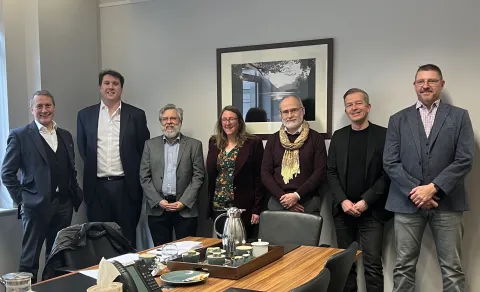We caught up with the team to find out what motivates them to be part of our SAB, and what trends they are currently seeing in biomedical research.
What motivates you to be part of ValiRx’s Scientific Advisory Board?
“The intellectual challenge, the freedom of thought, and the opportunity to encounter some truly amazing and novel projects within a company with the willingness and expertise to take them forward.”
Dr Wilson Caparrós-Wanderley (independent consultant)
“I am fundamentally a scientist but with business training and experience in commercialising technology, so what motivates me to work with ValiRx is the breadth of new science and potential clinical opportunities we get to review as well as the potential to transform patient care with innovative new medicines. Working with a great team to identify ground-breaking new approaches to treating unmet clinical needs, particularly in the underserved women’s health space, is very rewarding. It’s always good to stretch oneself intellectually and broaden our horizons and we have the opportunity to do this with the various programmes we review.”
Dr Mark Eccleston (OncoLytika Ltd)
“The ValiRx compound screening-to-SPV model offers a unique opportunity to engage with third parties and co-develop pharmaceuticals at an earlier stage than may otherwise attract larger financial investments by established pharmaceutical companies. The role of the SAB is to assess these compounds; select those in areas of unmet, or poorly met, medical need; and discuss subsequent potential evaluations with the partner, with a view to ultimately entering into a SPV arrangement.
“All compounds are evaluated with specific medical and commercial goals in mind, and a portfolio is being built to minimise risk and maximise the chances of success. As ValiRx is a publicly listed company, I am particularly interested in bridging the aims of a drug-development scientist, with that of a fruitful commercial business model, and the combination of these two aspects of the strategy greatly motivates me.”
Dr Adam Hargreaves (PathCelerate Limited)
“As part of the current collaboration agreement between Physiomics and ValiRx, Physiomics was offered a seat on the ValiRx SAB. As a keen enthusiast for innovation and drug development, I volunteered to fulfil this role.”
Dr Christophe Chassagnole (Physiomics PLC)
“My main motivation for being on the SAB is to continue a long and enjoyable working partnership with ValiRx CEO, Suzy. She’s achieved a great deal in her career and is an excellent role model for other women looking to pursue entrepreneurial careers in science. I’m impressed by Suzy’s determination to think differently about commercial science and its relationships with universities, as well as the way in which she looks at women’s health from different angles. Beyond that, it’s great for me in my university science research to be in touch with new developments and ways of thinking in the industry.”
Professor Paul Taylor (University of Leeds)
What trends are you currently seeing in biomedical research?
“An increasing interest and dependence in big data sets and high-level computing to address and de-risk the many challenges of drug discovery and development. Unfortunately, our ability as a scientific community to understand the underlying mathematics and, sometimes, even the basic assumptions made in the development of the software we are now relying on, has not kept pace with our ability to produce the ever-increasing volumes of raw data this approach requires.”
Dr Wilson Caparrós-Wanderley (independent consultant)
“There are two clear trends in biomedical research that I’ve seen emerging over the past decade. The first is biomarker led drug discovery which is driving the trend towards informed patient selection and personalised therapy. This has the potential to diagnose diseases earlier, direct the right patients to specific therapies, maximise response and minimise off target and side effects and therefore deliver significant improvements in disease management. The second is immune oncology where the power of the patient’s immune system can be sued to eradicate disease. Checkpoint inhibitors, cell therapies like CAR-T and CAR-NK approaches and epigenetic inhibitors to resensitise immune-tolerant cancer cells, as well as modulators of the tumour microenvironment offer exciting new opportunities to understand and treat cancer.”
Dr Mark Eccleston (OncoLytika Ltd)
“Trends in biomedical research have shifted away from the primary in-house generation of new drugs to a much greater degree of in-licensing. The ValiRx SPV model fills a void to enable much smaller and primarily academic institutions to scale out their new discoveries into a fit-for-commercialisation package. Recent publications have highlighted the attractions of the preclinical SPV model, and ValiRx is aiming to set the standard in this field. Also, as contract-research organisations have grown with increasing pharmaceutical company out-licensing, as an additional strand of the business, the development of the tCRO has been particularly impressive. By acquiring a truly novel and IP-protected series of patient-derived cancer cell lines, Inaphaea now has the ability to compete with very established CROs, but with an unparalleled range of services on offer. Having niche products to advertise, along with a solid base of scientific support, makes the laboratory highly attractive to new customers and the streamlined set-up is imparting a level of flexibility that can adapt to meet the needs of a diverse portfolio of potential new clients. On the drug development side, and not just in oncology, I have observed pipelines shift from small molecules toward biologics and in particular to bispecific and multi-specific compounds (Ab or Ab likes). This is noticeable not only in emerging biotech but also in established large pharma.”
Dr Adam Hargreaves (PathCelerate Limited)
“In my particular domain of interest - dosing and scheduling of cancer drugs - the recent Project Optimus initiative from the FDA has increased interest in model-informed decision tools and services. Project Optimus aims to create a paradigm shift for dose optimisation and selection from the Maximum Tolerated Dose (MTD) towards the finding of the Biological Effective Dose (BED) using modelling and simulation.”
Dr Christophe Chassagnole (Physiomics PLC)
“Here at the University of Leeds, I see continued focus on interdisciplinary, translational projects, with ever-growing teams from a wide spectrum of research fields. An area of significant current interest, and one I am engaging in, is the interaction of nutrition with health, disease, and therapy. As a chemist, I can see multiple ways to contribute to these inquiries. Finally, I would observe that the pandemic and the success of the vaccine programmes have encouraged large numbers of applications to study biomedical-focused courses at university. This means there will soon be an increase in highly motivated and well-qualified graduates entering the employment market in our field, which is an exciting opportunity for those who are ready!”
Professor Paul Taylor (University of Leeds)
The project review process
Following the initial internal review of a scientific project, the most promising are shared with the SAB members for their critical review. Those selected are assigned to one of the advisors who will champion the project. At this stage, a confidential disclosure agreement is signed with the innovators to allow us to review confidential information.
Discussions take place before the next SAB meeting where the new information is reviewed, with commercial negotiations happening alongside the confidential science reviews. The evaluation work is then scoped out, ready to be conducted once the evaluation license is executed, and contracts are finalised and signed by the innovators (and if they’re working at a university, its tech transfer office).
By providing transparent and expert scientific advice, our SAB is contributing to the progression of ValiRx’s project pipeline, including the project that became Cytolytix, and ultimately helping us to accelerate the development of treatments that improve patient lives.

To find out more about our SAB members, click here.
